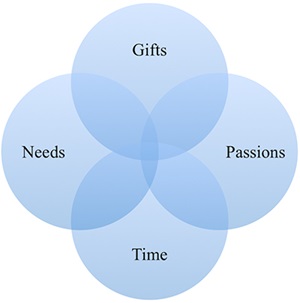4 Ways to Increase Volunteer Engagement
True engagement happens at the intersection of gifts, passions, time and needs
Every year, millions of people volunteer their time and talent to serve the church or partner with local nonprofit organizations. They invest their gifts and passions to make a meaningful difference, and to meet the needs of men and women, boys and girls.
According to the Bureau of Labor Statistics, 62.6 million people (about 25 percent of the U.S. population) volunteered through or for an organization at least once in a 12-month period. The most likely people to volunteer were 35-44 year-olds, then 45-54 year-olds, followed by teenagers 16-19 years old. The least likely to volunteer were 20-24 year-olds.
Recruiting volunteers is at the top of mind for pastors. Jesus said, “The harvest is great, but the workers are few” (Matthew 9:37, NLT). Pastors feel the frustration of the “few” and almost never stand up to announce, “Please, no more volunteers.”
Recently, the leader of a college campus ministry asked me what he should consider when recruiting volunteers: gifts, passions or ministry needs? The short answer is, “Yes!” In fact, I would add a fourth. Increasing volunteer engagement isn’t a single silver bullet. True engagement happens at the intersection of gifts, passions, time and needs.

GIFTS are the combination of abilities, skills and spiritual gifts that define how a volunteer can make his or her greatest contribution. Failure to understand the unique gifts of a volunteer will immediately reduce the possibility for meaningful engagement. When volunteers are trying to figure out whether or not they have a gift, ability or skill, have them answer these four questions:
- Am I satisfied? Every volunteer should experience fulfillment and satisfaction when using a gift, ability or skill. This doesn’t mean they will never feel anxious or uncertain; nor does it imply a posture of pride when it comes to identifying giftedness. Rather, “Am I satisfied?” helps a potential volunteer identify the genuine sense of fulfillment that should accompany the sweet spot of their gift mix.
- Is God glorified? There should be a sincere peace that God is being glorified when a volunteer uses a talent. This reveals motives, and it shows the “why” behind a person’s attempt at a certain gift, ability or skill.
- Are others edified? You should be able to point to evidence of a person’s gift. People and situations should be encouraged, strengthened or helped when the gift is in use. Nothing beats hard evidence. A volunteer’s talent should make things better?
- Is gifting verified? Does the volunteer have trustworthy people (who will speak honestly into their life) about their strengths? True gifting is usually verified by the positive, unsought feedback of others. Your observations will be especially helpful.
Positive answers to these four questions will usually provide reliable confirmation that a person has a specific gift, ability, or skill. Don’t throw out possible strengths if the answer to one of these questions is missing; however, do pay special attention to the areas where volunteers exhibit the greatest evidence. Finally, younger volunteers may need more experience before they can identify true giftedness. Be willing to provide opportunities to test the giftedness in real life scenarios. As leaders, when we ignore the gifting of a volunteer, we become self-serving rulers rather than people-empowering leaders. Gifting determines how the volunteer can help.
As leaders, when we ignore the gifting of a volunteer, we become self-serving rulers rather than people-empowering leaders.
PASSIONS compel people to serve. Passions are like the intrinsic motivation that drives people to volunteer time, talent and resources to make a difference. At the very least, we should help people discover their passions. Passions often fall in five categories:
- NEEDS I would love to meet
- PROBLEMS I feel called to solve
- PEOPLE I feel moved to serve
- ACTIVITIES I crave to do
- INTERESTS I’m compelled to pursue
Obviously, some passions fit in multiple categories. That’s okay. The goal is to surface the passions at the heart of volunteers. When we connect to a volunteer’s passion, they are more likely to make a longer commitment because they are doing what they love. Passion determines how long the volunteer will help.
TIME refers to the availability of the volunteer to serve in the church. People are becoming increasingly busy, but leaders must respond to these time restraints strategically. Just because a potential volunteer can’t make a big commitment doesn’t mean they won’t make any commitment. Think about time commitment in four ways:
- One-Time – How can a volunteer get their feet wet with a one-time experience? Service projects, one-time events, or easy activities are a great way to give volunteers a taste of a ministry.
- Preview – How can a volunteer preview a ministry area? This should be an opportunity observe before making a full-on commitment. Previews can save you, and the volunteer, time and unnecessary frustration.
- Rotation – Can the volunteer serve on a rotation basis? Serving once or twice per month is easier to swallow and reduces burnout.
- Expanding – What next step could expand a volunteer’s engagement? Just because a volunteer begins at an easy, less time-consuming level, doesn’t mean they aren’t willing to expand their commitment. Look for the right opportunities at the right time that match a volunteers gifts and passions.
Just because a potential volunteer can’t make a big commitment doesn’t mean they won’t make any commitment.
Leaders must architect entry opportunities that match the amount of time volunteers can contribute. Entry-level commitments often lead to expanded commitments. Time determines how often a volunteer will help.
NEEDS describe the roles, opportunities or openings where volunteers can serve in the church. This is usually where pastors focus their energy in the recruitment process because they feel the immediate pressure to get the roles filled. Be careful not to start with your needs, but rather with the volunteer’s gifts, passions and time. A volunteer’s unique design and capacity may actually meet a need that you didn’t even know you had. How God wired a person should influence the role or responsibility that you entrust to them. As you identify needs, be sure to create role descriptions and clear expectations. Needs determine where a volunteer can help.
As you recruit and release volunteers, consider the intersection between gifts, passions, time, and needs. It’s not always possible to hit on all four cylinders, but when we are so focused on meeting a need that we don’t stop to consider the capacity of the individual, we burn through volunteers. Volunteer engagement increases when we intentionally look for ways to help volunteers live in their serving sweet spot.
Stephen Blandino is the lead pastor of 7 City Church in Fort Worth, Texas. He blogs regularly at StephenBlandino.com, and is the author of Creating Your Church’s Culture and GO! Starting a Personal Growth Revolution.
Influence Magazine & The Healthy Church Network
© 2025 Assemblies of God

